Please Note- this website is best viewed on a desktop/laptop as it is not mobile-friendly. I am working on trying to convert it!
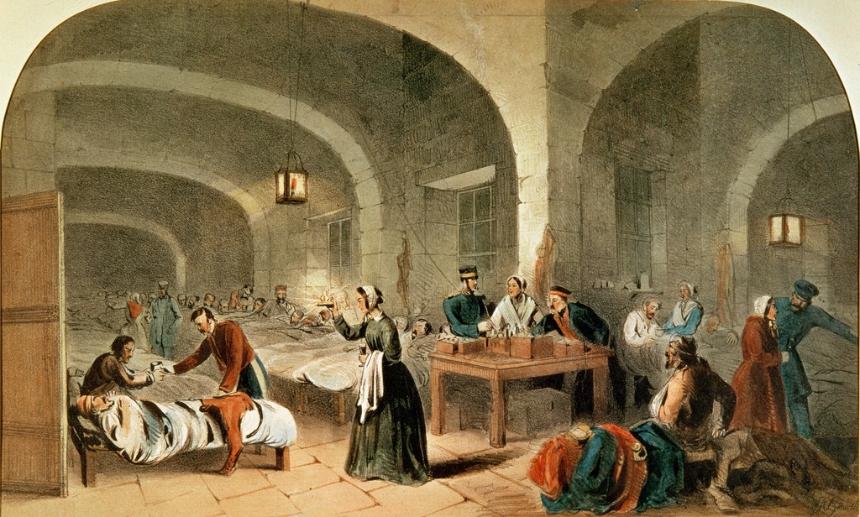
'Sketch of a ward at the hospital at Scutari' c1855. Or 'Florence Nightingale in the Military Hospital at Scutari’ (Turkey, Crimean War)
Coloured lithograph by and after Joseph Austin Benwell, published by Peter Jackson, The Caxton Press, London and Liverpool.
Miscellaneous and Travel Artwork
Although most of Joseph Austin Benwell’s artworks feature India (engravings), and later the Middle East ( paintings), many of his works depict scenes from other places all over the world.
Benwell's depiction of Florence Nightingale as the Lady with the Lamp ('Sketch of a ward at the hospital at Scutari', c1855, shown above) is one of his better known works. It is an iconic image, still used today to illustrate the life and times of the famous nurse. Ulrich Keller, in his book ‘The Ultimate Spectacle: A Visual History of the Crimean War’ (Routledge, 2002) states ‘If most Crimean hospital depictions spoke a decidedly romantic idiom, it must be emphasized in conclusion that one lithograph does seem to qualify as a reliable eyewitness account of the situation in the wards of Barracks Hospital. The artist of this undated but clearly contemporary print is the domestic artist J A Benwell, who must have made use of a fairly precise amateur drawing from Scutari. ……. - Benwell’s emphasis is indeed on organization, administration, professional service, and to this extent Nightingale’s work at Scutari did find at least one pictorial chronicler, after all.” I would, however, query the description ‘domestic artist’ used in the book.
Most artists depicting Florence Nightingale did so from their home base rather than from real life at Scutari. but Benwell's lithograph accurately depicts the structure of the building and the structural arches. In fact it is one of very few (if any) that shows them in this much detail. An early and iconic image published in the Illustrated London News on 24th February 1855 (Miss Nightingale, in the hospital, at Scutari') shows no background detail at all. I visited the former Scutari hospital in 2009, and was immediately struck by how accurately Benwell had depicted the interior structure. At the time, I had assumed that Benwell had been there on his travels, but now accept it is more likely he worked from home on this occasion, although he had travelled extensively to India and the Middle East both before and after the mid-1850s. The following is an extract from a family history article I wrote that was published after my visit:
“There is a small Florence Nightingale museum on the Asian side of Istanbul, located in a tower at Selimiye Barracks, known as Scutari during the Crimean War. Being in an army base there was quite a procedure to gain entry. We had to fax passport copies 48 hours in advance, state reasons why we wanted to visit and then wait for approval. We travelled across the Bosphorus Straits to the Asian side by ferry, went through security screening and were taken by minibus to another part of the complex to the museum. Just getting there was quite an adventure in itself!
Walking along the interminably long corridors to the tower which housed the museum, I recognised the original vaulted shapes of the ceilings shown in the painting, now whitewashed. Our guide confirmed that indeed these were the corridors that were used as wards to nurse the wounded soldiers of the Crimean War. Entering the upper level of the tower, it made our day to see Benwell's sketch hanging on the wall! It was fascinating to think he had been there in the 1850s, probably traversing the same straits we had just crossed. We ended our visit at the Haidar Pasha Cemetery, where an obelisk was erected in 1857 by Queen Victoria to commemorate British soldiers from the Crimean War.”
(extract from 'On the Ancestral Trail- From Berkshire to the Bosphorus' by Dee Murray, Family Tree magazine September 2010.)
Other engravings by Benwell on the topic of the Crimean War (1853-1856) include the lithograph 'The Heights of Alma - day after the battle' (21 September 1854) and .'Her Majesty taking leave of the Fusilier Guards previous to their departure to the East' (1856), showing Queen Victoria, - please see below.
During the 1850s and early 1860s, Benwell worked closely with travel writer and author Frederick Arthur Neale (1821-1863), providing many engravings to illustrate Neale’s text. Works include articles for the Illustrated London News, for example ‘Easter Pastimes in Syria’ and ‘A Fellah Wedding’ (1860 ); The Leisure Hour, for example ‘Tigers in India’ (1858) and Seaweed harvest in Jersey (1861); The Welcome Guest, for example ‘Tangiers. (1860); The Cornhill Magazine, for example ‘The Druses and Maronites’ (1860); and also articles in the ‘Sunday at Home’. Many of Neale’s articles and books are listed on various applications he made to the Royal Literary Fund between 1854 and 1862. Frederick Arthur Neale, who was born in Madras in 1821 and later resided in Jersey, is known for his books ‘Eight Years in Syria, Palestine and Asia Minor from 1842 to 1850’ (1851) and ‘Narrative of a Residence at the Capital of the Kingdom of Siam’ (1852).
The files, held at The British Library, also contain three letters from Benwell in support of Neale’s applications for funding, and acting as a referee. In the first letter, dated 2 June 1857, Benwell writes “….I beg to add my testimony to his fitness as an object for your bounty. During the whole term of my acquaintance with him, his health has been extremely bad and his pecuniary circumstances consequently most distressing.” It is apparent from this that Benwell had known, and worked with, Neale for quite some time. Other supportive letters in a similar vein are dated 31 May 1860 and 2 July 1862.
There is a rather sad post-script to Benwell's association with Frederick Arthur Neale, who was in poor health and who was believed to have died in 1863, aged 42. Benwell's last letter on file, dated 2 July 1862 to the Committee of the Royal Literary Fund states:
"My Lords and Gentlemen
I beg leave to bear testimony to the fact that Mr F A Neale of Jersey has been repeatedly disappointed in his endeavours to dispose of his manuscripts, after using every effort to do so. Permit me to add that a few days ago I was obliged to return to him about twenty … of some considerable length which I had had for some months in my possession, hoping some channels would open for him, but in which I was disappointed.
I have the honour to be, My Lords and Gentlemen, your most obedient servant.
J A Benwell, Artist and Contributor to the Periodicals"
It is therefore likely that at least twenty manuscripts (probably more) of travel writing by F A Neale were never published. There is no record on WorldCat or other such websites. Whether they still exist or not, I do not know.

'Her Majesty taking leave of the Fusilier Guards previous to their departure to the East' (steel engraving) from The History of the War with Russia, 1858 by Henry Tyrrell. Artist J Benwell, engraver T Sherratt (London, Crimean War)
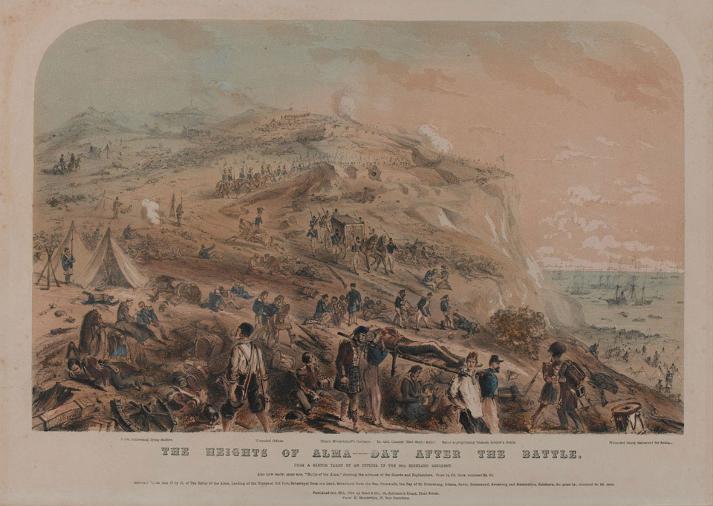
'The Heights of Alma - The Day After the Battle' 21 September 1854 (Crimea/Ukraine, Crimean War)
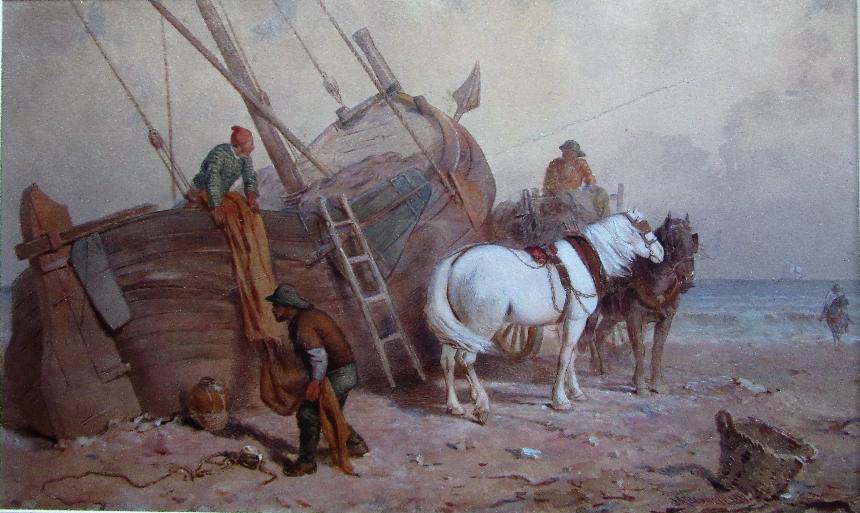
The Beached Boat' 1881, signed J A Benwell 1881 lower right, 34cm x 56cm (England)
This watercolour is one of Benwell's most unusual ones, depicting a domestic scene as opposed to an Orientalist scene, It is most likely a beach in the Bristol Channel near Weston-super-Mare, The Bristol Channel at Weston has a very large tidal range, the low tide mark being about a mile from the seafront. Boats were often stranded or 'beached' at low tide.
After returning from working in India in the 1840s, Benwell spent most of his working life in London, where he was born in 1816. However, his family moved back to the Somerset and Bristol area in about 1824, when he was a boy of about 8. He was brought up in Bristol, and had his first job there working in the office of Jacob Sturge, Land Agents and Surveyors in the early 1830s. before going to Calcutta to work for the East India Company for a number of years, returning in about 1850/51. He would visit his family in Bristol at regular intervals. By 1881, the date of this painting, the only close family left in the area were his older sister Charlotte Olivia (1811-1883) and brother-in-law Simon Michael Hayman (1812-1894), my greatx3 grandparents. Charlotte and Simon moved from Clifton, Bristol to Weston-super-Mare after retirement, where by 1871 they were running several small hotels/guest-houses on the seafront (Beach Road). In 1881, Benwell was living at 13 Abingdon Villas, Kensington, London, and my conjecture is that he made preliminary sketches for this painting whilst visiting his sister. Generally, he would have worked up his sketches into paintings back at his studio. By this time, it was some years since he had travelled to the Middle East, his major trip(s) having been made in the 1860s. Perhaps he was attracted by this little scene one day when on the coast, the flat beaches being reminiscent of the desert scenes he loved to paint. In particular, I would surmise that the white horse caught his eye, perhaps reminding him of the famous 'white camels' that he was so fond of including in his paintings.
I have come across one other painting of similar composition, 'Beach scene with figures and horses by a beached boat', signed and dated 1883, which was auctioned in 2010. The 1883 watercolour is smaller and there are several differences, for example there are seagulls but no figure riding a horse in the right background. Also differences in the figures, and the length and position of the ladder. Benwell quite often used to use his sketches to complete more than one painting, with slight variations on a theme.
It is unlikely that Benwell would have painted this scene for commercial or exhibition purposes - his genre was Orientalist scenes and he made his living painting these. I believe the painting could have been for his sister Charlotte, who he visited for holidays and lived in Weston-super-Mare, The 1883 copy may well have been worked up from his original sketch to mark the death of his sister in 1883.
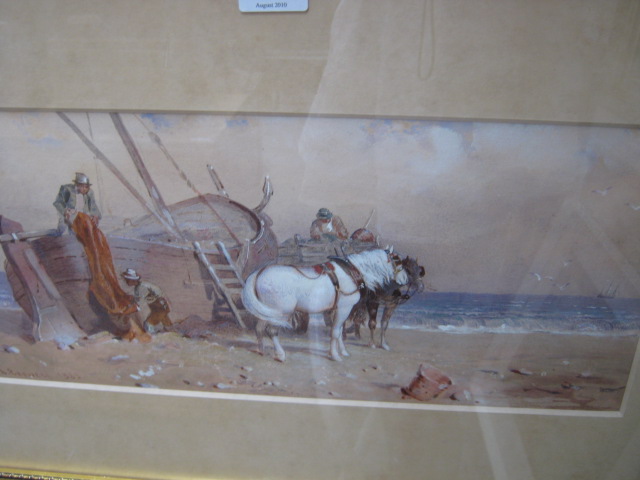
Below (extracts) - White horse England..................................
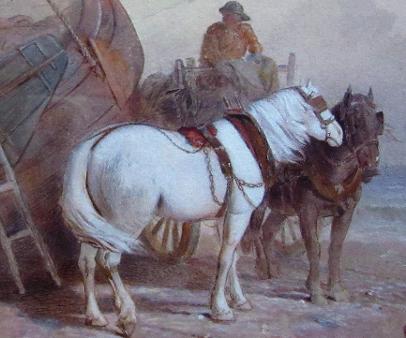
White camel, Middle East........................................................
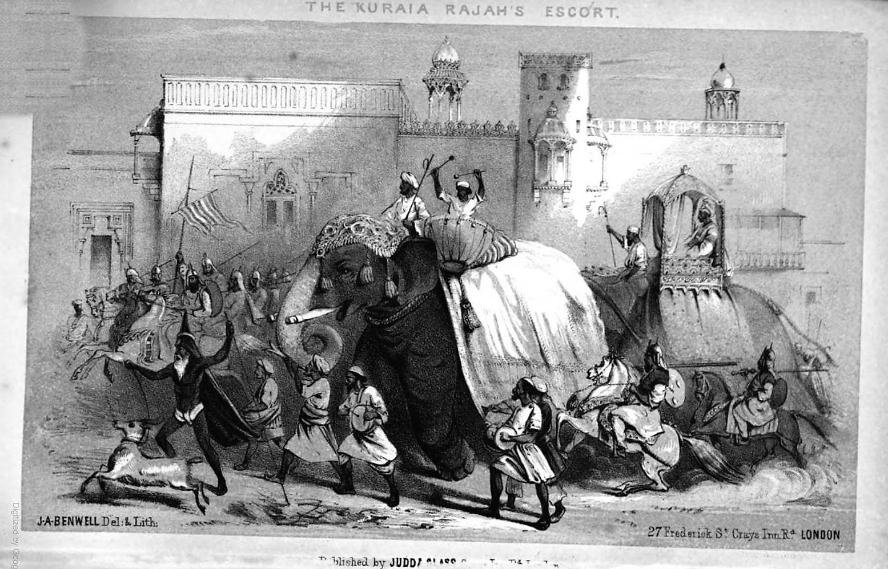
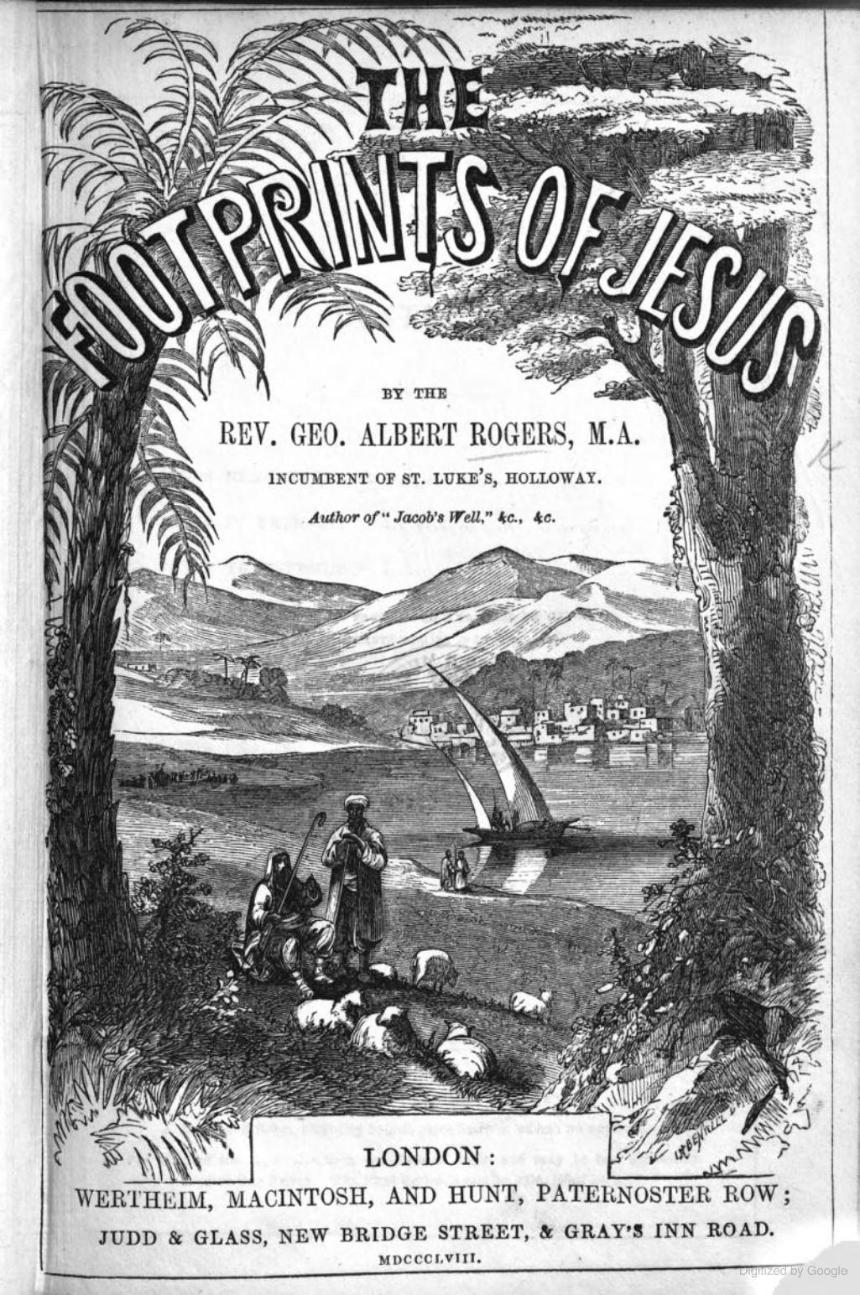
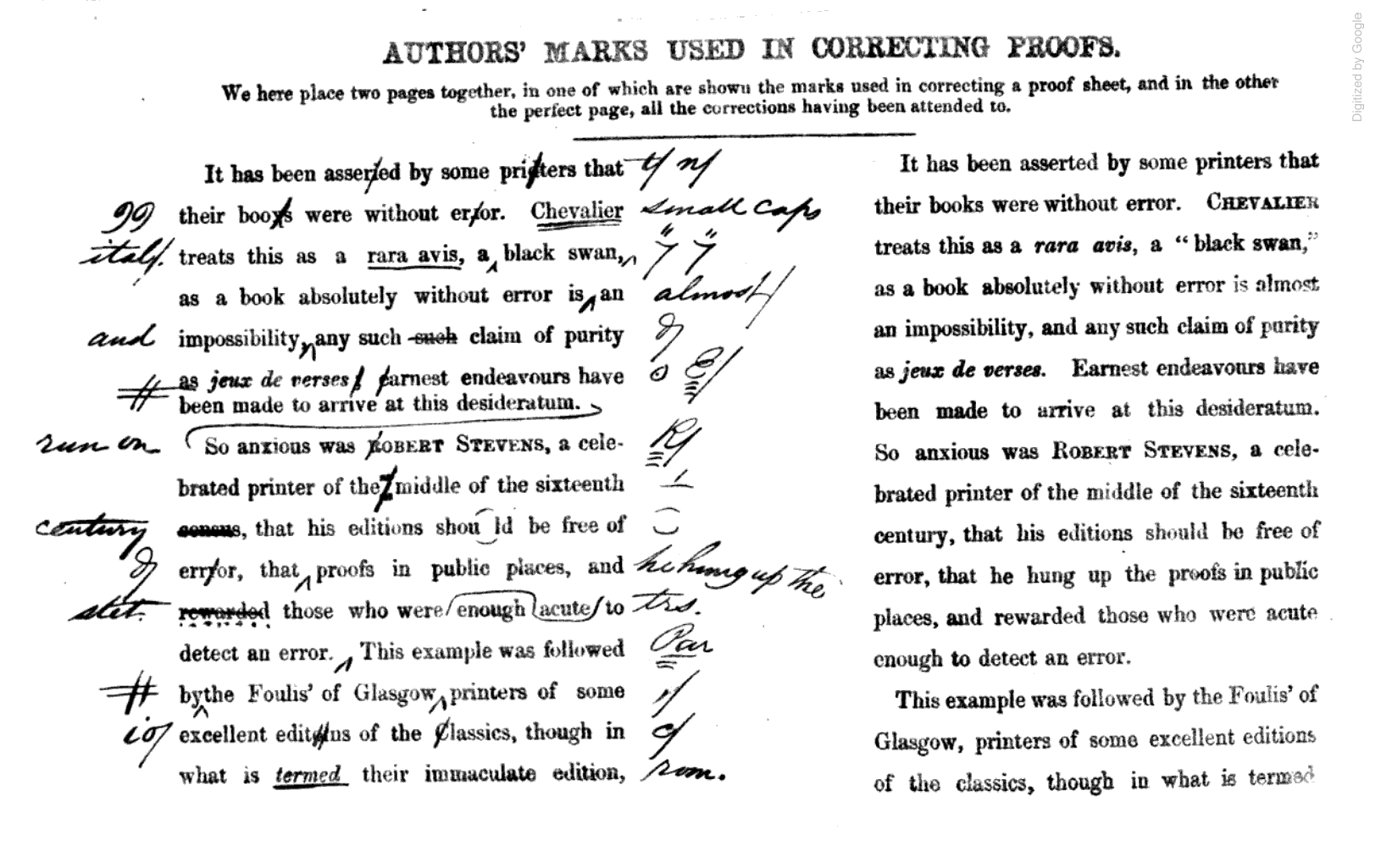
'Tunis water-carriers' Illustrated London News 1864 (Tunisia)
This engraving, in the Illustrated London News of 27 August 1864, may well be one of the last produced by Benwell. At around this time, he moved from producing engravings (mainly of India) to Orientalist watercolour paintings of Middle-Eastern scenes. In the same year (1864) he painted 'The Meeting Place', a painting signed and dated 1864, the earliest Orientalist painting of his that I have come across to date.
The accompanying text is useful in that it provides information about his travels, generally about which little is known. We know from this short article that in the early 1860s he visited Tunis, and then made quite a long overland journey to Egypt, presumably through Libya. This is interesting, in that the most straightforward route would have been via ship to Alexandria.
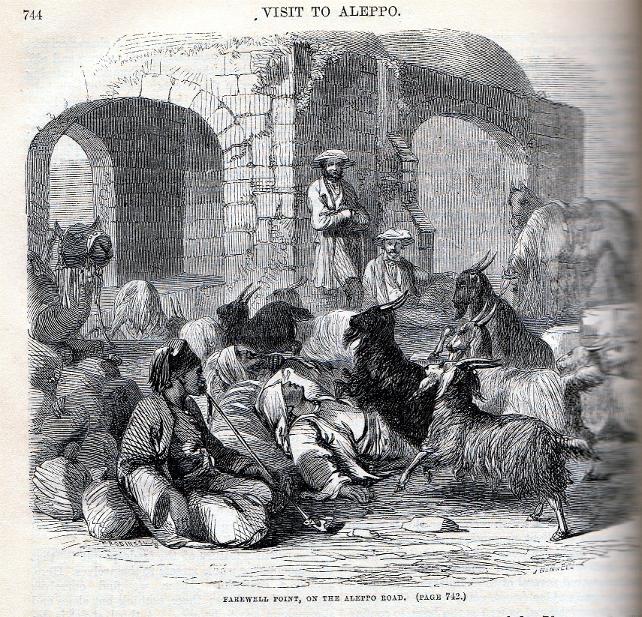
'Farewell point on the Aleppo Road'
from 'Visit to Aleppo in The Leisure Hour' 22 November 1860 (Syria)
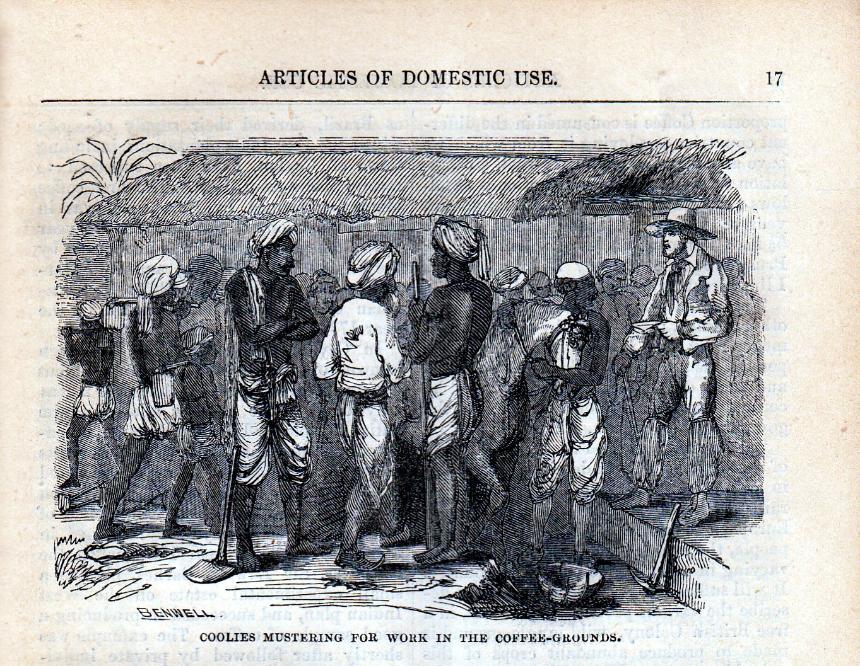
'Coolies mustering for work in the coffee-grounds'. Family Friend vol VI, 1854.
Published by Wm S Orr and Co., Amen Corner, Paternoster Row
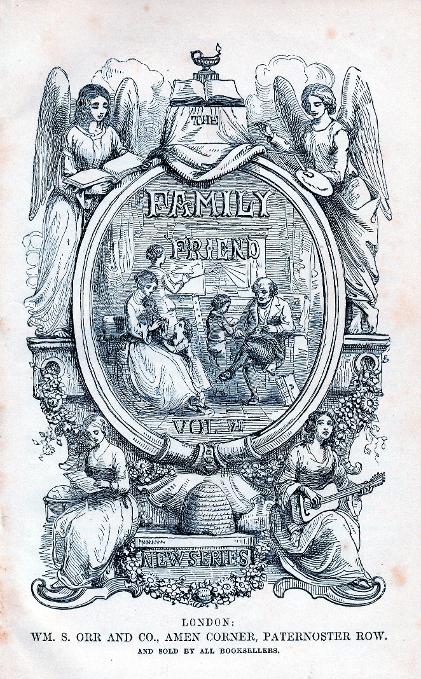
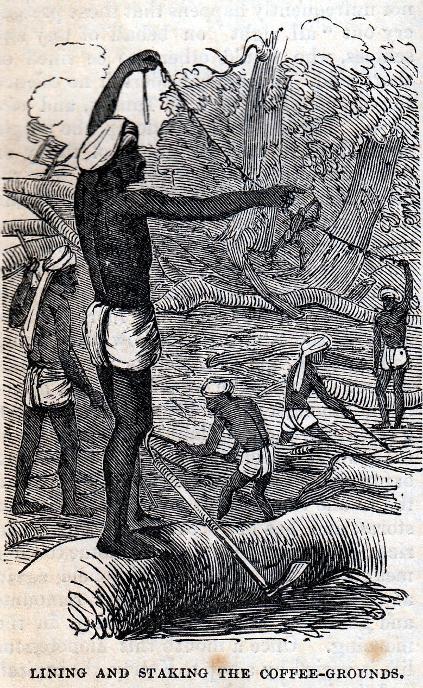

'The Prince of Wales at Machpelah' 7 April 1862 (Israel).
'The Prince of Wales at Machpelah' is a colour lithograph and is the frontispiece of 'Sunday at Home' 1863 (see below)
Also known as the Cave of the Patriarchs or the Sanctuary of Abraham and Ibrahimi Mosque. located in the old city of Hebron. Abraham, Isaac and Jacob are believed to be buried there. It is one of the holiest places in Israel.
Page 7 - "So jealously have the tombs been guarded that it is believed no European had visited them for nearly seven hundred years, or since the times of the Crusades. .... The only European who had lately been admitted to the sacred precincts, previous to the Prince of Wales and his suite, is Signor Pierotti, who visited it in company with Sooraya Pasha , and was allowed to make a careful survey of the mosque, and to descend towards the sacred cave as far as the Pasha himself is permitted to go. Leaving all the former doubtful and stealthy attempts to see the cave of Machpelah, we come to the recent and authentic visit of our Prince, in company with Canon Stanley, Dr Rosen, and other intelligent attendants. The Pasha of Jerusalem, when made acquainted with His Royal Highness's desire to visit the cave, after some delay at last consented."
Extract from 'The Eclectic Review' 1862, by William Henry Stowell. Page 551. Kronheim print 'The Prince of Wales at Machpelah' painted by Benwell
'Diving for sponges on the coast of Syria' Illustrated London News 23 August 1862 (Syria)
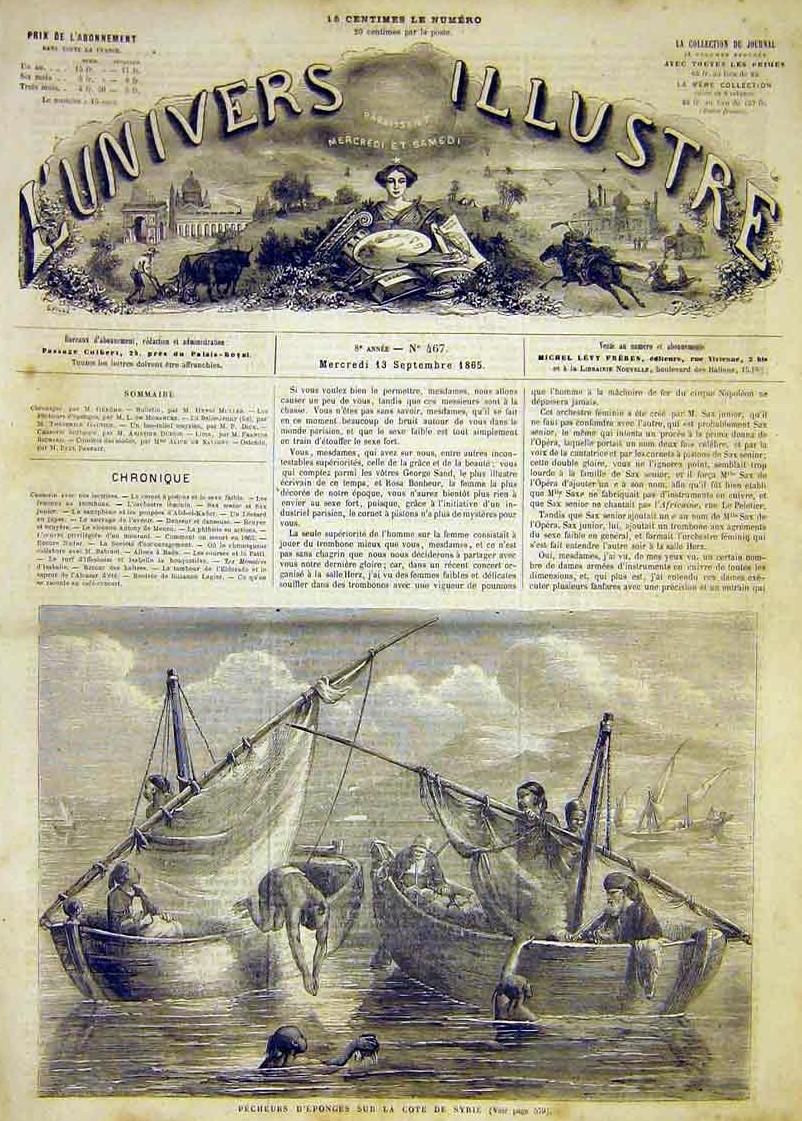
'Pecheurs d'eponges sur la cote de Syrie' (engraving as above in the ILN) in the French journal 'L'Univers Illustre' 13 September 1865
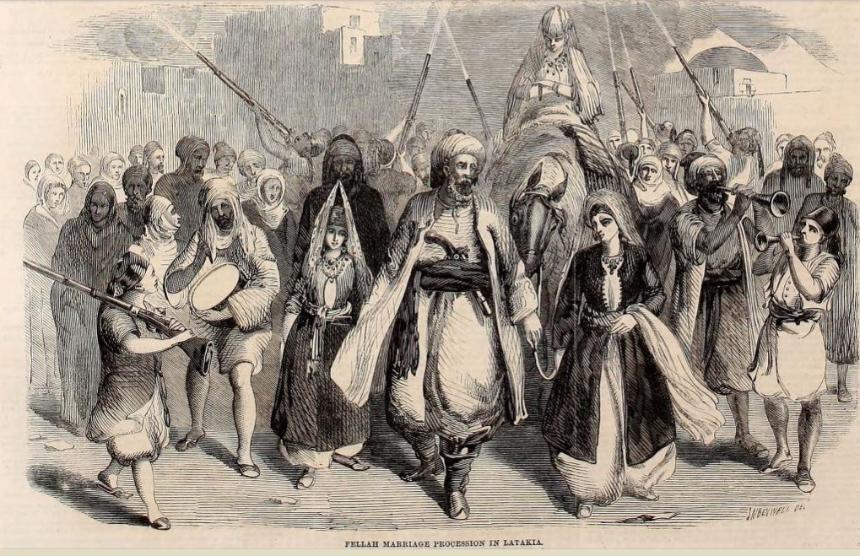
'Fellah Marriage Procession in Latakia' Illustrated London News 1860 (Syria)
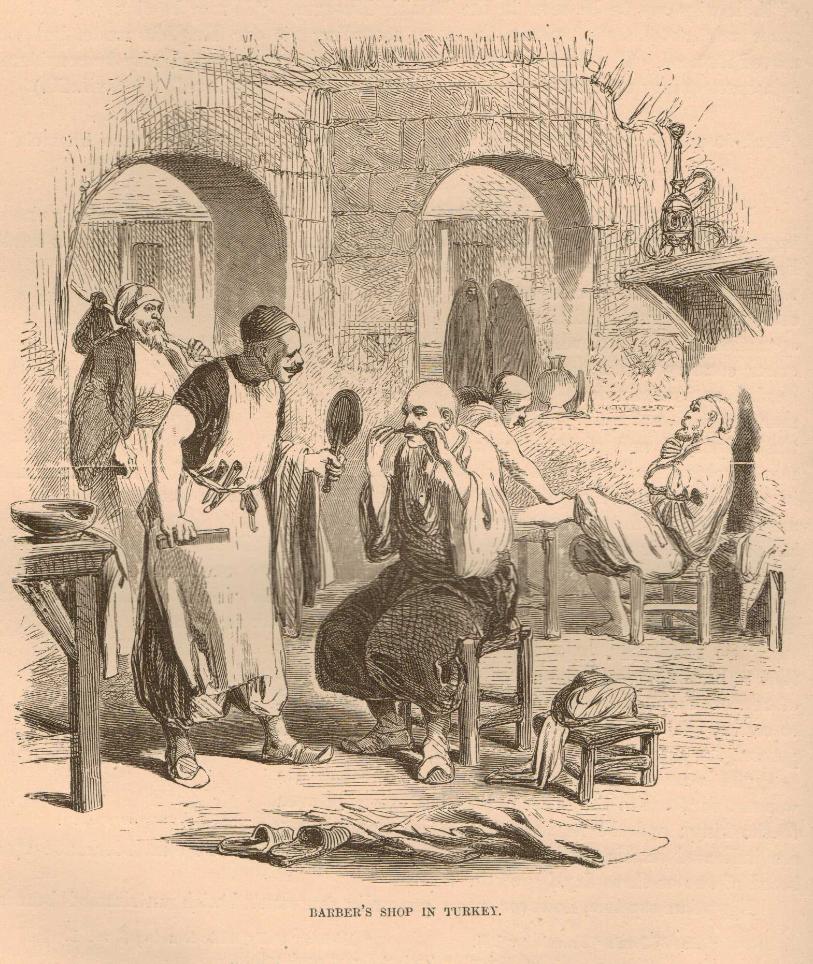
Barber's Shop in Turkey' from ‘Rays from The East, or Illustrations of the Holy Scriptures,
derived principally from the Manners, Customs, Rites, and Antiquities of Eastern Nations’ 1871 (Turkey)

Cover of 'Rays from the East' (1871)
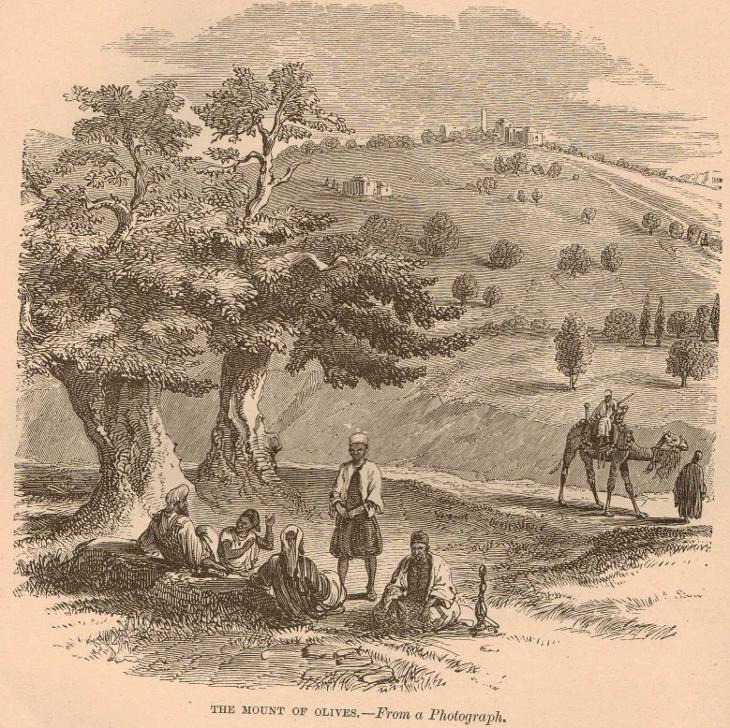
'The Mount of Olives - From a Photograph' from ‘Rays from The East, or Illustrations of the Holy Scriptures, derived principally from the Manners, Customs, Rites, and Antiquities of Eastern Nations’ 1871 (The Holy Land/Israel)
This illustration also appeared in ‘The Sunday at Home, a Family Magazine for Sabbath Reading’ 1859, where it is signed C P Nicholls, lower left and J Benwell, lower right. I have found that when engravings are used again in later publications, the original signature of the artist is often obscured or omitted.

'Arabian Hospitality Tent' from ‘Rays from The East, or Illustrations of the Holy Scriptures, derived principally from the Manners, Customs, Rites, and Antiquities of Eastern Nations’ 1871 (Iraq)
'
Page 10, 'Arabian Hospitality' - "Mr Buckingham was travelling over a plain, on his way to Orfah, the "Ur" of the Bible, when in the evening of the day he came to a number of tents, in the centre of which was that of the Sheikh, or head of one division of the tribe. "When we alighted at his tent door", he says, "our horses were taken from us by his son, a young man, well dressed. His father was sitting beneath the awning in front of the tent itself, and rose up to receive us, exchanging the salute of welcome, and not seating himself till all his guests were accommodated." ..........."While we were talking, a meal was preparing for us within; and soon afterwards, warm cakes baked on the hearth, cream, honey, butter, raisins, curds, and wheat boiled in milk, were served to the company.""
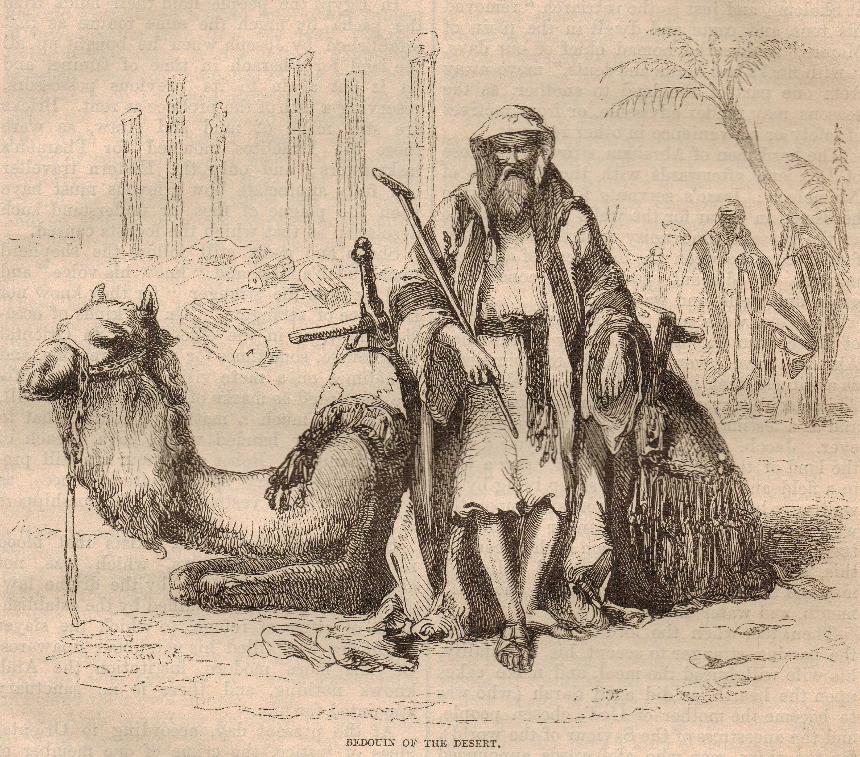
'Bedouin of the Desert' from ‘The Sunday at Home, a Family Magazine for Sabbath Reading’ 1861 (Egypt)
Page 500 - "No stronger instance can be adduced of that permanency of Oriental customs to which reference has been made, than the short stick which the Arab we have engraved carries in his hand, for in the hands of figures sculptured on the most ancient Egyptian monuments, this stick is held. This stick, which has thus been perpetuated for nearly four thousand years, upon granite, and basalt, and marble, is identical in form and proportions with that carried by almost every Arab in our days from the Euphrates to the Nile."
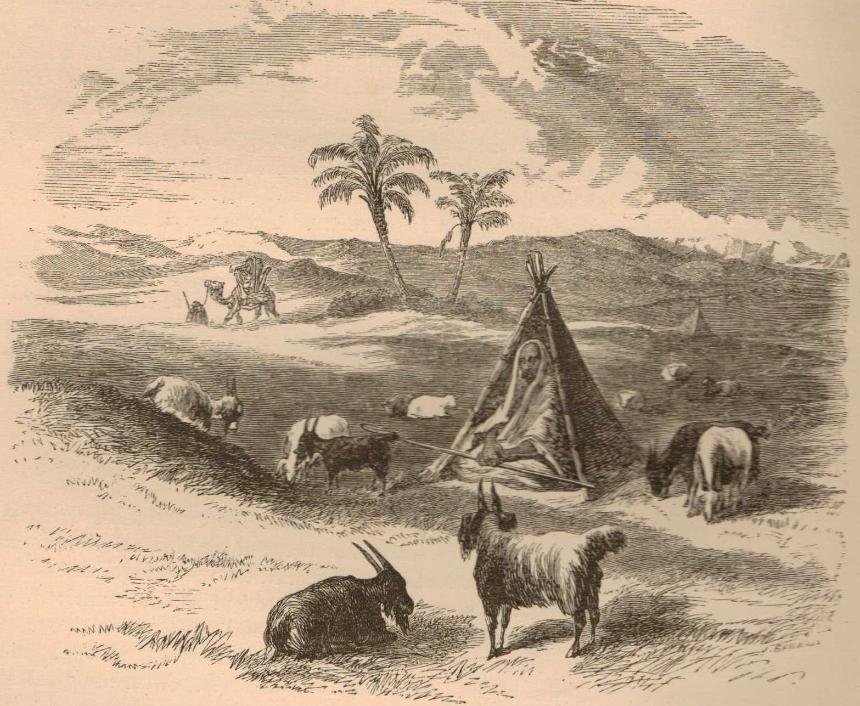
'Eastern shepherd in tent' from 'Rays from The East, or Illustrations of the Holy Scriptures, derived principally from the Manners, Customs, Rites, and Antiquities of Eastern Nations’ 1871 (Syria)
Page 17 - "Nothing can be more simple in construction than the tent of an Oriental shepherd. which, in all probability, represents the tents of patriarchal times. It consists of three poles, each about four feet in length, which are tied together at the top, and spread out at the lower end, so as to enclose a space of ground sufficient for a man to sit in. The whole is covered in canvas made of goat's hair, coarse in texture and black in colour. In this tent the shepherd sits all the day through, and rolls himself up in it for sleep at night. He removes it at pleasure with the greatest of ease."
'The Embarkation' from 'A Photographic Expedition in Burmah', The Leisure Hour 1863 (Burma)
'The Embarkation' from 'A Photographic Expedition in Burmah', The Leisure Hour 1863 (Burma)
Page 632 - "On the 6th February, 1862, my husband and myself left Thayet Myo, a small military station about five or six miles from the boundary of British Burmah, on a photographic expedition to the ruined city of Paghan, and to the modern city of Mandelay, the present capital of Burmah. We engaged for ourselves a low-roofed boat, which was to serve as our drawingroom by day, and, by the help of some temporary curtains, as our dressing and bedroom by night. The forepart of the boat was occupied by our crew, which consisted of the master of the craft, a fine stalwart Burman, two assistant boatmen. and an old man and small boy, the two latter apparently shipped for ballast. Another boat followed with our servants, viz: a Mussulman Sepoy who acted as cook; a Burman lad, or loo-galay as he is termed, and a Chinaman who rejoiced in the name Moses and the office of interpreter...."
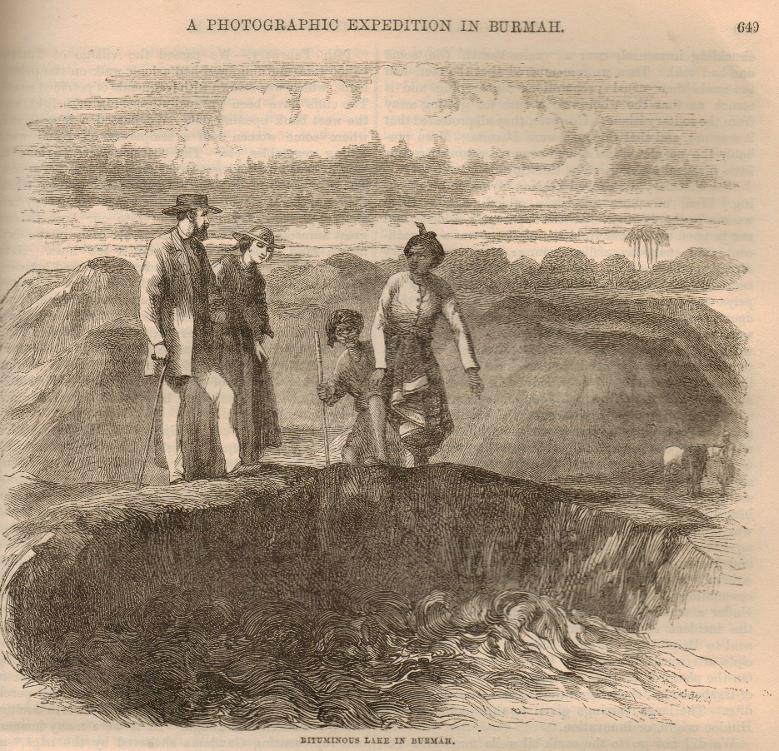
'Bituminous lake in Burmah' from 'A Photographic Expedition in Burmah', The Leisure Hour 1863 (Burma)
'
Page 648 - "We reached Memboo a little before sunset, and started immediately to see the Mud Volcanoes. ..... Passing through the town, we came into a low jungle, and proceeded for a mile or more, until a sudden turn in the road brought us to the strangest sight imaginable. Six or eight high peaked hills, looking like gigantic termites, were dotted about over a plain of dried. flaky mud. some of these cones terminated in a hollow, or crater, and this crater was filled with dark-looking mud, from which issued a strong smell of petroleum, as the Burman with us immediately remarked. The liquid mud bubbled up as if boiling , and it was a few moments before one ventured to ascertain, by the touch, that it was really cold. There was no one near the volcanoes but ourselves, and, in the silence of the still evening, the bubbling from the different craters could be distinctly heard, like the slow boiling of huge cauldrons. .... The ground was covered with the dried channels of the mud as it had flowed from the volcanoes. These streams, which we watched in their liquid state, rolling down the sides of the cones, were invariably formed alike- a rivulet running straight on between two banks of mud, the sides being marked at right angles from the middle flow."

'Pictorial History of the Nutmeg' The Leisure Hour 1857 (Malaya and other countries)
'Pictorial History of the Nutmeg' The Leisure Hour 1857 (Malaya and other countries)
Page 87 - "The island of Penang may now be said to consist of one great plantation of nutmeg and fruit trees.... Glugar is situated , in the interior of the island, about an hour's smart drive from the seaside. The plantation covers a space of several miles, including undulating hills and extensive valleys........ A representation of the fruit, just bursting open, may be seen in the centre of the accompanying engraving, which is intended to illustrate pictorially the several processes through which the nutmeg passes, from the shaking of the tree to bring down the ripe fruit, to its use in the kitchen by the thrifty housewife or the cook....... Here is a room quite filled with baskets and fragrant with spicy aroma, in which some persons are employed in weighing nutmegs or mace, while others are noting down the number of piculs ( weight equal to about 133 lbs. English; some are carrying off the weighed baskets to the packing room, where they are duly packed in ready-made cases, having their respective quantities marked on them in Chinese hieroglyphics of an inch and a half in depth. Close at hand are the workshops of some ten or a dozen Chinese carpenters, who throughout the day, and that every day of the year (Sundays excepted), are perpetually at work, sawing, cutting, hacking, hammering, nailing, and finishing the wooden cases requisite for the spices; their long tails, meantime, proving a source of endless annoyance to them, from either getting entangled amongst the sharp teeth of the saws, or being firmly nailed into some packing case........ The ship sails; but her voyage is a tedious one, she being much buffeted about off the Cape of Good Hope......... and the next time we recognise the cases with the Chinese hieroglyphics, we find them piled up like a pyramid in the London or St Katharine's Docks. A fortnight later, and we may lay out a penny in the purchase of one of these nutmegs at a grocer's not far from Tower Hill."
'Sea-weed harvest in Jersey' The Leisure Hour 1861 (Jersey, Channel Islands)
'Sea-weed harvest in Jersey' The Leisure Hour 1861 (Jersey, Channel Islands)
Page 487 - "There is abundance of sea-weed at all seasons of the year, to be picked up at the sea-side during low water; and vast quantities are collected and consumed by the poorer classes, first as fuel for their own domestic purposes, and then the ashes are disposed of to farmers and landed proprietors, who use it as manure. But it is strictly forbidden, under heavy penalty, to cut the vraick from off the rocks except at this particular season of the year; and, as the season for cutting it is limited, and the cutting can only be accomplished during the brief intervals that the tide is out, night and day the people are indefatigable in raping as much as they can...... Everybody in Jersey has something to say about sea-weed on this glorious 8th of March. The butcher at his stall, slicing off goodly steaks, speaks loudly of the benefit the vraick will be to the pasturage, and so increase the weight and substance and even flavour of the meat. The old woman who rears pigs is in mental rapture at the rapid growth of mangel wurzel and turnip radishes, wherewith to fatten her pork into alternate layers of lean and fat......The very hens are going to take kindly to laying, with such a splendid perspective before them of grubs amongst the sea-weed..... Everything and everybody sings in praise of vraick to-day."
Illustrations from 'Narratives for Youth; vol 2, publ. John Stabb English Monthly Tract Society, [1852?]. The Curious Crab, and The Redwings' Flight
Illustrations from 'Narratives for Youth; vol 2, publ. John Stabb English Monthly Tract Society, [1852?]. The Broken Bough, and True Courage
Illustration from 'Narratives for Youth; vol 2, publ. John Stabb English Monthly Tract Society, [1852?]. The Secret Revealed, and cover
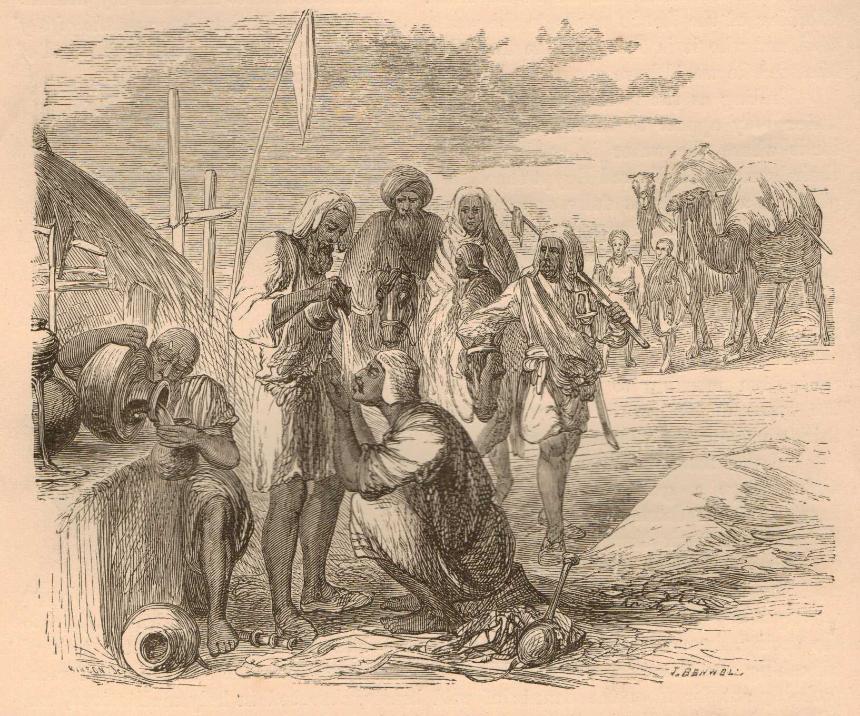
'Eastern Travellers refreshed by the gift of water' from 'Rays from The East’ 1871.
Also in ‘The Sunday at Home, a Family Magazine for Sabbath Reading’ 1857 (India, similar practices in Egypt)
in ‘The Sunday at Home, a Family Magazine for Sabbath Reading’ 1857 (India, similar practices in Egypt)
Page 215 (Sunday at Home' - "In India, the value of such a present is sufficiently appreciated. The Hindoos will frequently, in a dry season, fetch water from a great distance, and at considerable pains, to boil it and prepare it for travellers, that they may drink it with safety. The hospitable Hindoo will then take his stand in some open road, from morning to night, and offer the water in his jar to whatever weary and thirsty passengers may come that way. The accompanying sketch represents two who are thus engaged. One of them is busy pouring the water into his lota or drinking-cup, that he may present it to the party approaching. The other, standing up, is giving drink, in the name of his gods, to a solitary and forlorn pilgrim, who has thrown his staff on the ground, and in his eager gratitude bends humbly down to receive the welcome shower along the palms of his hands."
Chinese Mandarin being presented with satin shoes' from The Picture Gallery of the Nations, 1861 (China)
'
Page 161 - 'On approaching a town, there is frequently seen a number of boots and shoes, dusty and tumbling in pieces, hanging against the principal gate. These have been presentations of honour,; as it is customary to offer boots, made of satin, to any mandarin who has obtained a character for good government. After his death, these are hung up at the gate, and are regarded as among the glories of the place."
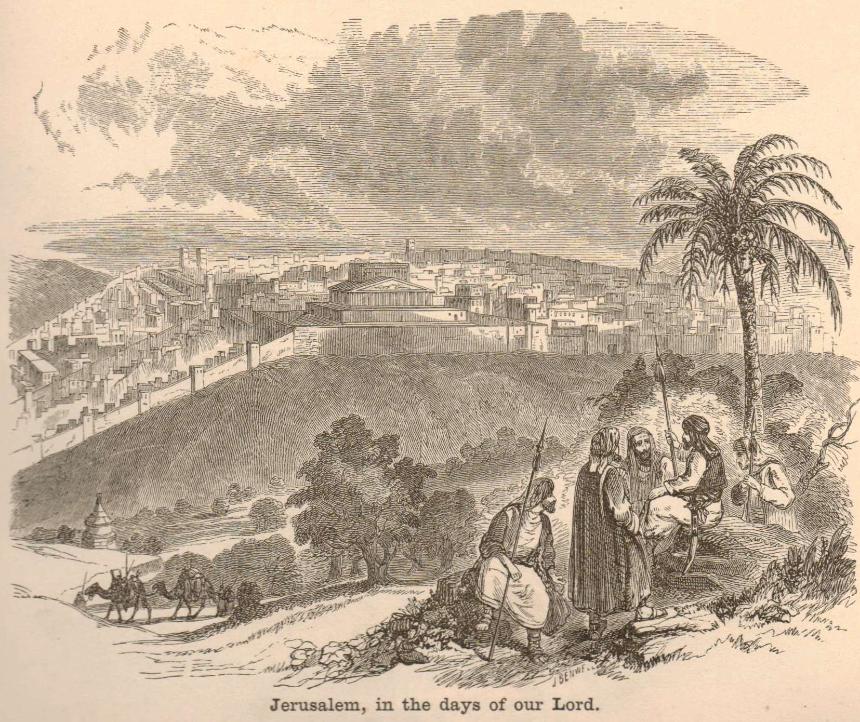
'Jerusalem, in the days of our Lord' from The Picture Scrap Book, 1864 (Israel/Holy Land)
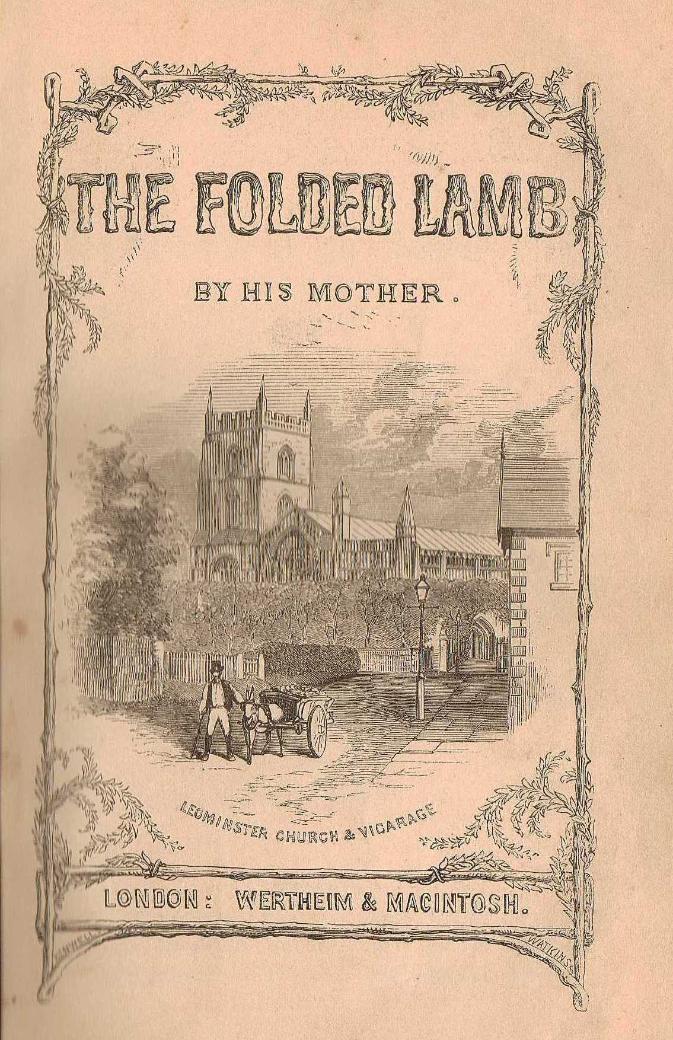
Title page of 'The Folded Lamb, or, Memorials of an Infant son' by Ellen M Rogers, 1857. Leominster Church & Vicarage - Benwell and Watkins
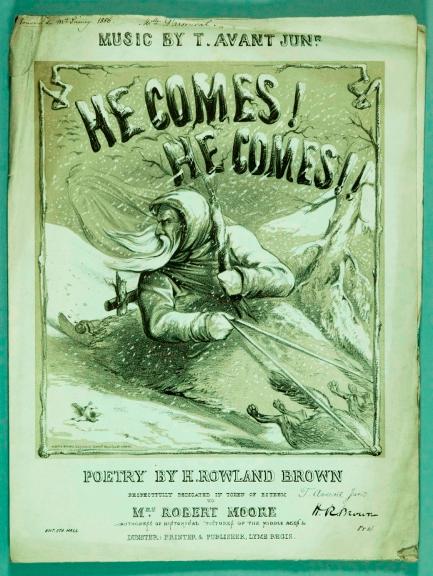
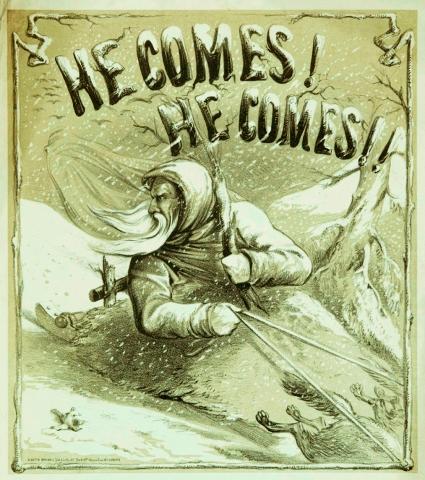
Title page of "He Comes! He Comes!!" Music by T Avant junr, poetry by H Rowland Brown, published Dunster, Lyme Regis c1855.
Title page lithograph by Joseph Austin Benwell (Del & Lith), address (lower left corner): '27 Fredk St, Grays Inn Rd, London'
Image courtesy of Special Collections, University of Bristol Library (Pinney Music Collection, Pinney Papers)
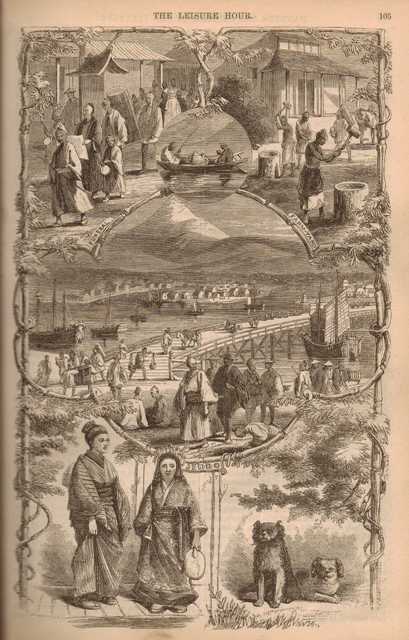
'Manners and Customs of the Japanese' The Leisure Hour 1859 (Japan).
Top left - Funeral, top right - Farm-yard, centre- Jeddo. Jeddo is an anglicisation of Edo, the Japanese town and port , the name being commonly used by English-speaking people during the 1850s. In 1868, Edo was renamed as Tokyo.
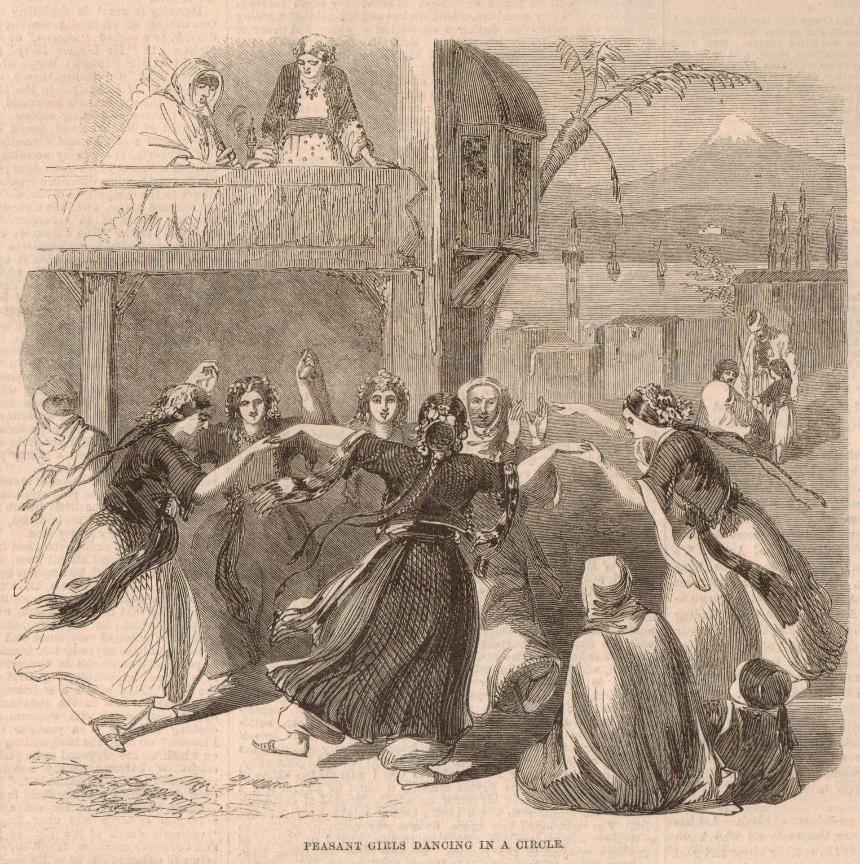
Easter Pastimes in Syria - Peasant Girls dancing in a Circle' Illustrated London News 1860 (Syria)
''.......the distant Mount Cassius is still snowcapped. The Bay of Antioch is seen in the sketch, and the distant headlands of Latakia.'
'The Market Women of Marseilles' The Leisure Hour 1857 (France)
'The Washerwomen of Marseilles' The Leisure Hour 1857 (France)
Page 218 - ".......we attain the summit of the hill just behind our lodgings in the Rue Minimes. Here, rosy with health and wholesome labour, inhaling unimpeded the pleasant sea breeze that sweeps up from the Mediterranean, are a small colony of laundresses, with sleeves tucked up, and steeped to their elbows in soap-suds. Fantastically grouped round a considerable stone and mortar reservoir , which is liberally supplied with water from a neighbouring fountain, these hard working women make the air resound to the music of pleasant ditties, as they lash the linen unmercifully against the smooth hard surfaces of the borders of the reservoir......
Their mode of procedure differs materially from that usually followed by the English washerwomen. They eschew hot water, and consequently consume no coals. The soiled linen is steeped in a perforated jar, filled with wood ashes and water; in twenty-four hours or less, the water has all dripped through, and the linen is then conveyed to this reservoir where it is thoroughly washed, well beaten, and then hung out to dry; and then ironed and brought home, few shirts shall rival in neatness and whiteness those that are got up by these laundresses at Marseilles."
'The Beggars' Stairs, Malta' The Leisure Hour 1857 (Malta)
'Marketing in Alexandria' The Leisure Hour 1857 (Egypt)
Page 345 - "We accordingly take another volunteer into the service, and after buying a few deliciously fresh oranges and figs, turn back towards the butchers' streets, whence to the left, in a wide open square, just behind the Norwegian Consulate, is situated the fish and poultry market....... There is corn yet in Egypt, ay, and abundance of good fruit and vegetables besides."
'Crocodile over the gateway at Siout' The Leisure Hour 1857 (Egypt)
Page 359-60 - "The Egyptians call the crocodile Timsah; and there is a wild lake in the desert, called Lake Timsah, where thousands of crocodiles are seen. A little further up the river we one day saw a boy sitting by the bank and crying piteously, while his flock of goats stood around him..... He said that a crocodile, lurking by the place where his goats went to drink, had suddenly opened his fearful jaws and snapped up one of them. In a few days more, the same crocodile took another goat, and the boy ran at once to the nearest town, as he was told to do: (the name of this town is Siout, and it is reputed to be the place where our Saviour was taken by Joseph and Mary, when they fled into Egypt, by the direction of an angel, to save the young child from Herod's cruelty.
The animal was not slain until four persons had been killed.Ropes were then fastened to his huge carcass, and it was drawn back triumphantly to the town. Here it was suspended, over the entrance of the principal gate, where we saw it, and made the sketch from which the accompanying wood-cut is taken."
'The Camel-Driver's bivouac among the mountains' The Leisure Hour 1857 (Turkey)
'The Camel-Driver's bivouac among the mountains' The Leisure Hour 1857 (Turkey)
Taurus Mountains, southern Turkey- Page 74 - "The snow has been scooped out and swept away to the sides; the heat of the fire has imparted warmth to the ground; and the sons of Ishmael glory in their bivouac, recounting wild legends of love, of home, or of warfare. The night is far advanced, and the fire burns low, when they wrap themselves warmly in their sheepskins, and huddle together under the shelter of bales, so built up as to constitute a temporary retreat "
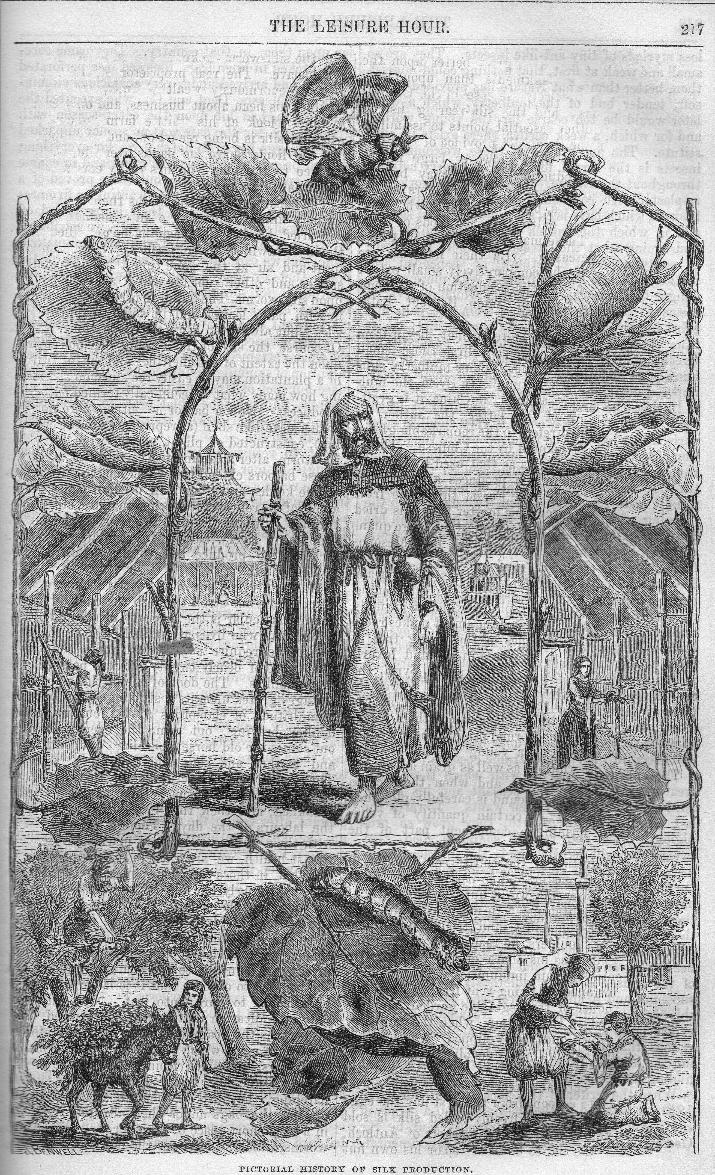
'Pictorial History of Silk production' The Leisure Hour 1858 (Syria)
Page 218 - "On the morning of the third day, as soon as the sun has dried up all the moisture from the leaves, the result of heavy Syrian night dews, then the axe is heard felling branch after branch from the mulberry trees. This precaution is imperative upon the silk-rearer, because the slightest moisture on the leaves would inevitably destroy the worms. When a sufficient number of branches have been felled, donkeys are laden with them and driven to the front door of the kokh, where the leaves are detached and carefully spread over the batoors: the branches themselves are thrown aside to dry in the sun and accumulate for a winter stock of fuel, and the worms are removed from the flat baskets and placed in these batoors, there to remain until they are formally ensconced in their impenetrable cocoons."
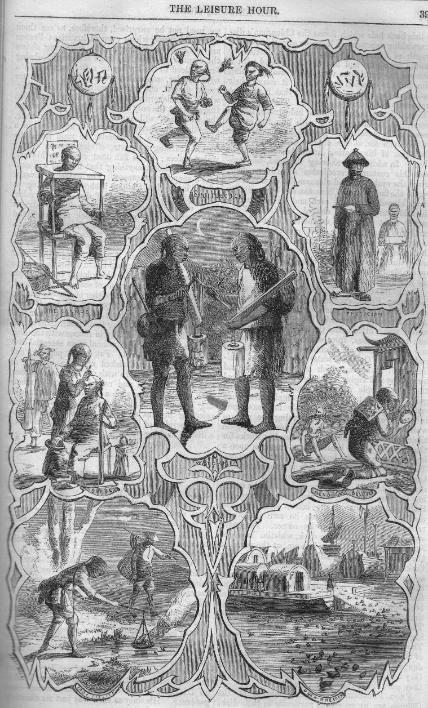
'Out-door life in China' The Leisure Hour 1858 (China)
From top centre clockwise: Shuttlecock, Physician, Mendicant Devotee, Duck-Breeder, Frog Fishing, Barber, The Canque, centre- Watchmen

'Peripatetic trades in China' The Leisure Hour 1858 (China)
From top left clockwise: The Moneychanger, The Swanpan, Basket Maker, Snake Seller, Pedlar, Pipe Vendor, Street Musician, centre- Lantern-Seller
'The Chinese Provision Dealer's Sail-Barrow' The Leisure Hour 1858 (China)
''Page 201 - "Another article of food, for which there is an equally large demand, is the teu-feu, a kind of bread made of beans ground into flour, and shaped into pieces about six inches in thickness. This also is prepared in various ways, being frequently boiled in water, fried, or eaten raw. From the emperor to the lowest peasant, everyone is passionately fond of the teu-feu, which is one of the cheapest and most nutritious of the comestibles used in China. Our illustration represents a vehicle in common use with the hawkers of these commodities. This cart however contains, in addition to those mentioned, a basket of fruit, a box of tea, some bamboo pipes, and a jar of wine, the top of which is covered with white clay to preserve it from contact with the air. The high roads in China are kept in perfect repair, which facilitates the action of the wind upon the sails of these light carriages."
The Chinese Provision Dealer's Sail-Barrow' The Leisure Hour 1858 (China)
'The Syrian Auctioneer' The Leisure Hour 1858 (Syria)
Page 441 - ""Harage! Harage! Harage!" The auctioneer seizes upon a handsome piece of Tripoli silk shawling, and, cutting away the binding, flings it at full length over the heads of the surrounding crowds, so that they may at once appreciate its size and beauty...... The auction proceeds. There are Hebrews with flowing beards and dusky robes, amongst the bidders; there are camel-drivers, just like the pictures one sees of Eleazar the Syrian at the well; there are Persians, in their queer shaped caps; dervishes, with their characteristic attire; muftis, ulemas, soldiers, sailors, tinkers and tailors; Greeks, Armenians, Turks, Druses, Syrians, Arabs, Copts, Egyptians, Swiss, Swedes, Americans, English, French, Italians, Austrians etc. etc. ...."
'Games of the Druses' Cornhill Magazine vol 2 1860 (Lebanon)
Page 375 - "The sublime mountain scenery...... groups of richly-dressed horsemen......a magnificent and spirit-stirring spectacle"
Page 376 - "After about a quarter of an hour's practice, the horsemen divide into two parties, stationing themselves at opposite extremeties of the Meidan, about a dozen opponents on either side being on the field, and the sport of the day commences. The djereed is a long stick about an inch in diameter, and a yard and a half in length, but blunt and round at both ends."
'A Street Scene in Tangiers' The Welcome Guest, a Magazine of Recreative Reading for All 1860 (Morocco)
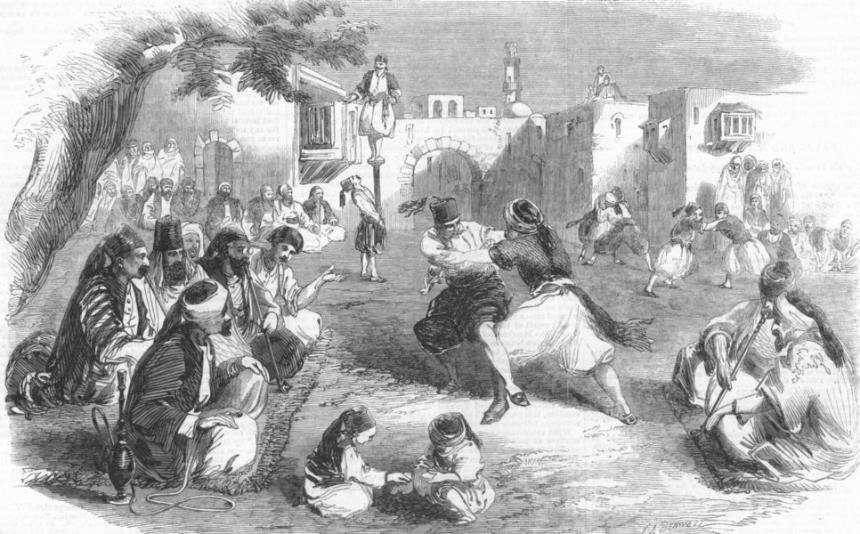
'Easter Pastimes in Syria' -'The Shebab (young unmarried men) engaged in athletic sports' Illustrated London News 1860 (Syria)
Page 332 - "After a substantial breakfast the shebab, or young unmarried men, of the village resort, under a chosen chief of the festival, to an open plain, near the residence of the chief landed proprietor, where, in his presence, the old priest, friends, and head men of the village, who are seated on rugs with divan cushions to recline against (as represented in the accompanying Illustration) indulge in athletic games , never for a moment losing their tempers or or suffering defeat, however ignominious, to give rise to even to a frown or an angry word.
In the foreground are two lads, sons of the proprietor, who are amusing themselves at that favourite Syrian easter pastime, Baida; they are each furnished with gaily-coloured hard-boiled eggs, of which every house in the village has a supply of some hundreds; for Christmas without turkey and plum=pudding wold not be more terrible than Easter without coloured eggs to the Syrio-Greel peasant. The boys are knocking the eggs together at the sharp end of the oval to see who has got the hardest. The egg which first cracks is lost, and is immediately devoured by the winner. The little villain to the right has, who has the appetite of a vulture and made a most astounding breakfast, has since that meal won and swallowed fifteen hard-boiled eggs, and he means to try and eat fifteen more, to give him an appetite for his dinner."
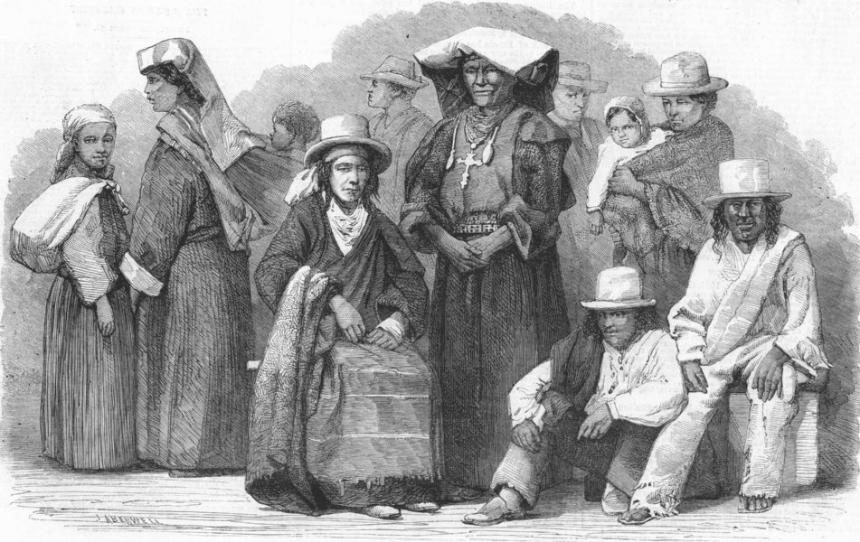
'Indians of Peru and Bolivia, South America' Illustrated London News 1864 (Peru, Bolivia)
'The Chinese Bell' Sunday at Home 1857 (China)
Page 743 - "It was suspended in an elegant frame, to add to its comeliness and to give free scope to its vibrations. It was not provided with a tongue like those that are hung in the belfries of our towers and steeples, but was struck with a staff or hammer. .... Before the bell was invented, a piece of flint, jade, or agate, was hung up in Chinese temples. and being struck with a metallic staff, yielded a sharp ringing sound. The Chinese, indeed, still retain this prototype of the bell, and regard it as peculiarly consecrated to the rites of worship. "
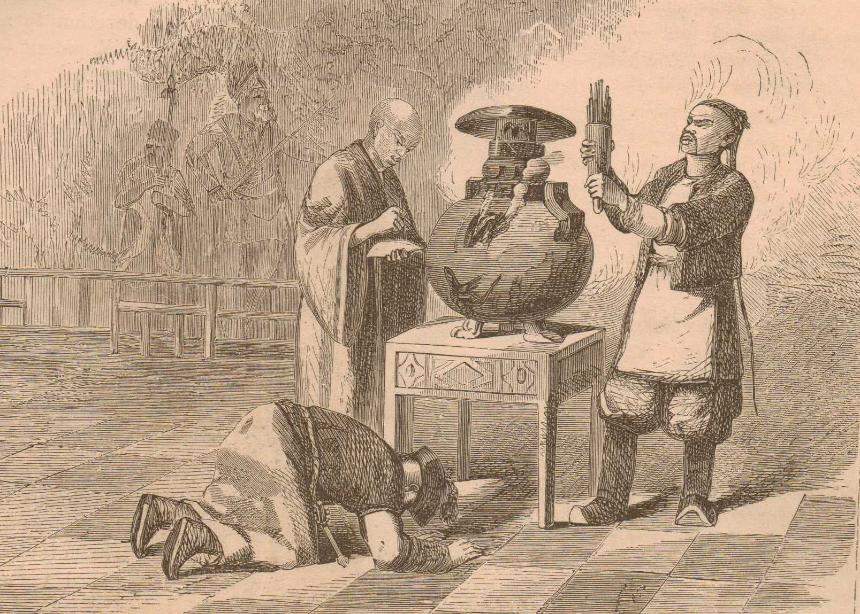
Appealing to the Oracle' The Oriental Picture Gallery, Rev John Liggins, 1866 (China)
Also appears as 'Consulting the Oracle' in Sunday at Home 1858
'A Marvellous Escape' Sunday at Home 1857 (Labrador, North America)
'An Indian Reservation' Sunday at Home 1857 (Seneca Indians, North America)
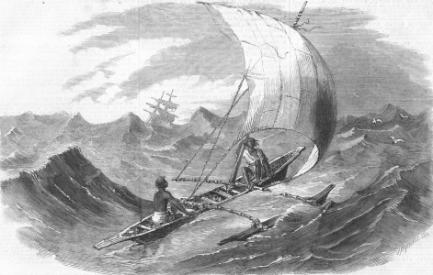
'Cinghalese Boat' Illustrated London News 1860 (Ceylon/Sri Lanka)
"The boat shown in the accompanying engraving is a familiar object to the voyager along the Malabar coast, or the luxuriant shores of the Island of Ceylon; and it never fails to call forth the admiration of the stranger for its graceful motion in the water, as well as for the skill with which the swarthy boatmen manage the huge sail, so utterly at variance with European notions of the proportion which the sail ought to bear to a boat's hull. As soon, however, as it comes more within view the means are apparent by which the light boat is made to sustain such heavy rigging. A canoe-shaped float of sold wood is projected and sustained from the boat's side by outriggers , which are secured by lashings to the mast and gunwales, as seen in the Illustration. Whichever way the wind sets, the float has the effect of counterbalancing the side pressure on the sail."
'A Malagasy tomb' Sunday at Home 1859 (Madagascar), also in '‘Madagascar and its People. Notes of a Four Years' Residence' by James Sibree, 1870
'A Malagasy tomb' Sunday at Home 1859 (Madagascar), also in '‘Madagascar and its People. Notes of a Four Years' Residence' by James Sibree, 1870
"In many places in the neighbourhood of Antananarivo there are a number of ancient graves which are commonly called those of the Vazimba, the reputed aboriginal inhabitants. These are regarded with great reverence and even dread, from the belief that these Vazimba are a kind of demon or demigod, some being malicious and others benevolent."
'Rescue of the drowning Mandarin' The Leisure Hour 1857 (China)
'Bethelsdorp' Sunday at Home 1863 (South Africa)
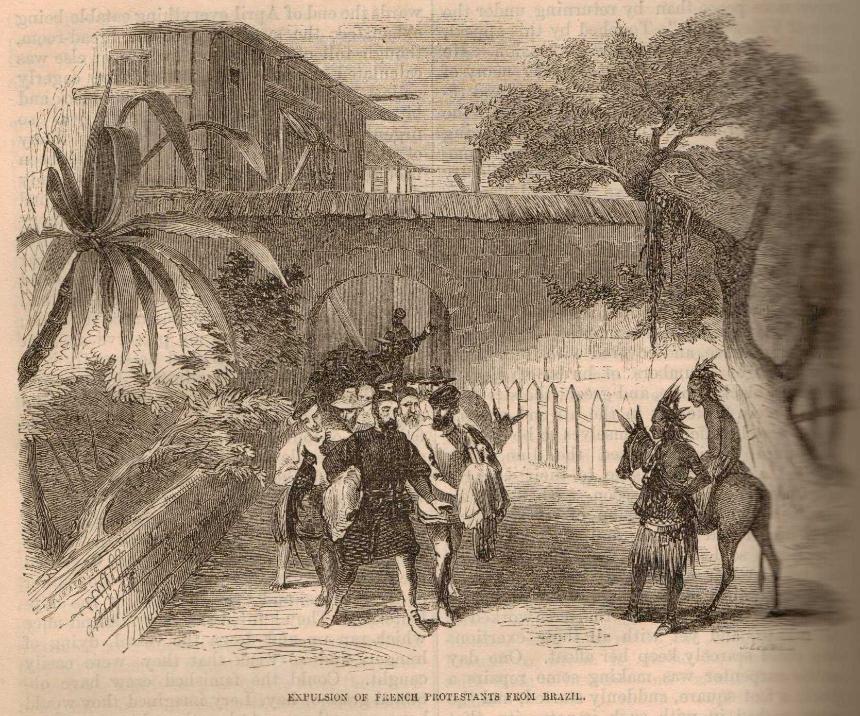
'Expulsion of French Protestants from Brazil' from Sunday at Home, 1857.
Also appears in ‘A Home in the Land of Snows and other Sketches of Missionary Life’, 1870 by Miss Brightwell (Brazil, South America'
'Expulsion of French Protestants from Brazil' from Sunday at Home, 1857. Also appears in ‘A Home in the Land of Snows and other Sketches of Missionary Life’, 1870 by Miss Brightwell (Brazil, South America'
"In the year 1555, Nicholas de Villegagnon, a knight of Malta, a man of distinguished talents, and high in the French naval service, having abjured the Roman Catholic faith, formed the design of establishing a colony of Protestants on the coast of Brazil, in South America. ......he requested further reinforcements, especially "some good divines from Geneva, to introduce the Christian faith among the natives." ......By degrees he evinced a spirit of mistrust towards the newly arrived company, and from being their protector eventually became their enemy and persecutor. Before long they were obliged to hold their religious services without him...... Their conscientious perseverance in the observance of their religious duties incensed the governor more and more, so that at length he declared that he would not suffer their presence within the fort, he compelled them to retire from the shelter of the very place they had assisted in building for mutual security."'The Judean Shepherd' Sunday at Home 1857 (or 'Palestinian Shepherd with his flock' ) (Palestine)
Page 391 - "There is something so human, so beautiful, so peculiar, and so pathetic about a flock of sheep in their relation to their shepherd, that we do not in the least marvel to find the pastoral life abundantly employed by ancient writers to afford emblems, parables, and and illustrations of the most important and noble among purely human relationships."
'Could they have been sketched by Bushmen?' Sunday at Home 1859 (South Africa)
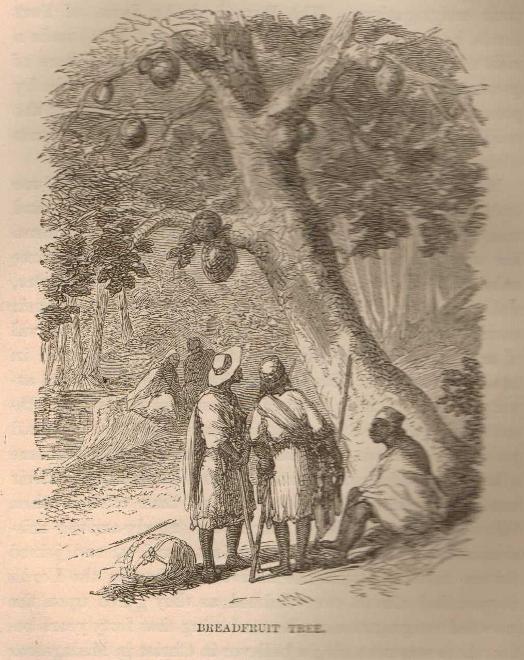
'Breadfruit Tree' Madagascar and its People by James Sibree, 1870 (Madagascar)
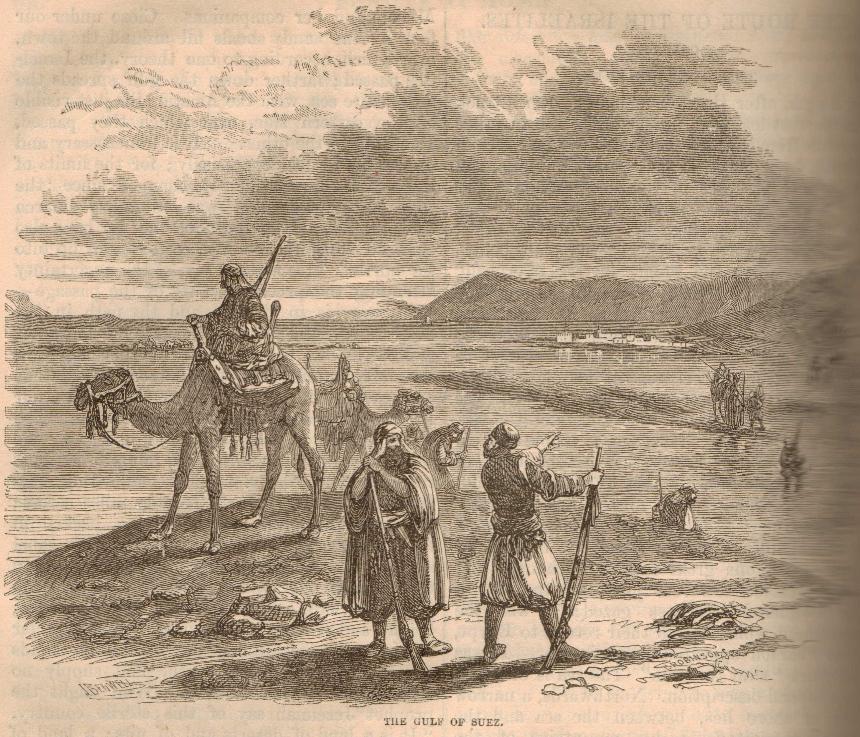
'The Gulf of Suez' Sunday at Home 1856 (Egypt)
'The Gulf of Suez' Sunday at Home 1856 (Egypt)
Page 647 - "The sea is blue and clear beyond description. Northwards, a narrow strip of shore lies, between the sea and the brown, precipitous rocky mountains of the Egyptian coast. To the north-east, with the blue gulf between, lies the white line of Suez; and the Indian steamer is discernible, moored a few miles below. The Arabian hills, soft in their amethyst hues, shut in the whole to the east."
'Site of Ancient Samaria; Sunday at Home 1860 (Samaria, part of ancient Israel)
Page 488, The Rainless and Dewless Years, Chapter 1.
Joseph Austin Benwell's art - Victorian Religious Publications
Joseph Austin Benwell's art - Scenes from India (please refer to this section for engravings featuring India, not included above)
Joseph Austin Benwell's art - Orientalist Art
Art Research - other Bristol artists and miscellaneous (including George Cumberland 1754-1848)
Material researched and written by Dee Murray. Website compiled by Dee Murray. All rights reserved.
All images on this website are either scanned or photographed from the author’s own resources, appear with permission of owners/copyright holders, or are in the public domain in digital format via websites such as HathiTrust, Openlibrary.org, the Internet Archive (archive.org) or Google Books.